» Site Map
» Home Page
Historical Info
» Find Friends - Search Old Service and Genealogy Records
» History
» QAIMNS for India
» QAIMNS First World War
» Territorial Force Nursing Service TFNS
» WW1 Soldiers Medical Records
» Field Ambulance No.4
» The Battle of Arras 1917
» The German Advance
» Warlencourt Casualty Clearing Station World War One
» NO 32 CCS Brandhoek - The Battle of Passchendaele
» Chain of Evacuation of Wounded Soldiers
» Allied Advance - Hundred Days Offensive
» Life After War
» Auxiliary Hospitals
» War Graves Nurses
» Book of Remembrance
» Example of Mentioned in Despatches Letter
» Love Stories
» Autograph Book World War One
» World War 1 Letters
» Service Scrapbooks
» QA World War Two
» Africa Second World War
» War Diaries of Sisters
» D Day Normandy Landings
» Belsen Concentration Camp
» Italian Sailor POW Camps India World War Two
» VE Day
» Voluntary Aid Detachment
» National Service
» Korean War
» Gulf War
» Op Telic
» Op Gritrock
» Royal Red Cross Decoration
» Colonels In Chief
» Chief Nursing Officer Army
» Director Army Nursing Services (DANS)
» Colonel Commandant
» Matrons In Chief (QAIMNS)
Follow us on Twitter:

» Grey and Scarlet Corps March
» Order of Precedence
» Motto
» QA Memorial National Arboretum
» NMA Heroes Square Paving Stone
» NMA Nursing Memorial
» Memorial Window
» Stained Glass Window
» Army Medical Services Monument
» Recruitment Posters
» QA Association
» Standard
» QA and AMS Prayer and Hymn
» Books
» Museums
Former Army Hospitals
UK
» Army Chest Unit
» Cowglen Glasgow
» CMH Aldershot
» Colchester
» Craiglockhart
» DKMH Catterick
» Duke of Connaught Unit Northern Ireland
» Endell Street
» First Eastern General Hospital Trinity College Cambridge
» Ghosts
» Hospital Ghosts
» Haslar
» King George Military Hospital Stamford Street London
» QA Centre
» QAMH Millbank
» QEMH Woolwich
» Medical Reception Station Brunei and MRS Kuching Borneo Malaysia
» Military Maternity Hospital Woolwich
» Musgrave Park Belfast
» Netley
» Royal Chelsea Hospital
» Royal Herbert
» Royal Brighton Pavilion Indian Hospital
» School of Physiotherapy
» Station Hospital Ranikhet
» Station Hospital Suez
» Tidworth
» Ghost Hunt at Tidworth Garrison Barracks
» Wheatley
France
» Ambulance Trains
» Hospital Barges
» Ambulance Flotilla
» Hospital Ships
Germany
» Berlin
» Hamburg
» Hannover
» Hostert
» Iserlohn
» Munster
» Rinteln
» Wuppertal
Cyprus
» TPMH RAF Akrotiri
» Dhekelia
» Nicosia
Egypt
» Alexandria
China
» Shanghai
Hong Kong
» Bowen Road
» Mount Kellett
» Wylie Road Kings Park
Malaya
» Kamunting
» Kinrara
» Kluang
» Penang
» Singapore
» Tanglin
» Terendak
Overseas Old British Military Hospitals
» Belize
» Falklands
» Gibraltar
» Kaduna
» Klagenfurt
» BMH Malta
» Nairobi
» Nepal
Middle East
» Benghazi
» Tripoli
Field Hospitals
» Camp Bastion Field Hospital and Medical Treatment Facility MTF Helmand Territory Southern Afghanistan
» TA Field Hospitals and Field Ambulances
Russian and Polish Prisoner of War Refugees WWII 34th British Commonwealth General Hospital
Part 8 of the War Diaries of QAIMNS Acting Principle Matron Lieutenant Colonel Hughes where she describes the care of former Prisoner of War Polish refugees from Russia who had many illnesses and diseases such as typhus, dysentery, malaria, tuberculosis and frostbite at 34th BCGH
Read part seven on the Indian Army Medical Corps page.
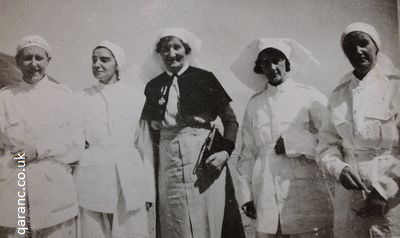
Camel convoys were the chief means of transport in the mountains which were still covered with snow and with narrow, deep ravines on either side making the road difficult and dangerous, but the Royal Army Medical Corps units got through to Pahlevi and started to unpack in readiness. Before the day was out, someone looking vaguely through the blizzard spotted three ships approaching - if you could call them ships: they were not fit for the use of human beings or cattle - across the Caspian Sea. The vessels anchored and rapidly disgorged their contents of humanity on the beaches. What a shock for everyone - this sight would never be forgotten! The smell was too awful to describe. There were thousands of both sexes of all ages, packed like sardines, and they could not lie down or even sit. They were emaciated, being skin and bone only, filthy and lousy, the dead and the dying all mixed up together, sent over without food or drink, no sanitary arrangements, and with the weak trying to hold each other up. They were dressed in bits of old, dirty rags, some almost naked, with no shoes, and crawling with bugs. Practically every disease in medical history was evident there- typhus of the worst type, dysentery, malaria, tuberculosis, frostbite, some with limbs almost dropping off with disease. There were just a handful of the fairly healthy mixed up with the typhus cases. They had received no medical attention, the kiddies' bodies naked but covered with embedded lice under the skin. Tuberculosis was at its worst among the children under four years of age, their little tummies all blown up, limbs and faces all shrivelled up and outlining only the bone formation, and they were too ill and weak to cry.
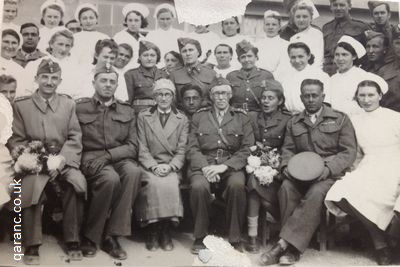
The bath unit and disinfector could not be used for all the cases, many being too ill and the numbers too great to be dealt with. Our chief anxiety was to get them to the hospital at Dosham Tapu for immediate treatment, so we sorted out those able to make the journey. The language question was a drawback at first, having an all Indian staff and the patients Polish and a few Russians, but this was soon overcome, being only a minor detail. Over one thousand were admitted to the hospital on the first day. We had only five hundred beds, so the remainder, as a temporary measure had to lie on folded blankets on the ground. The fatigue party put up more tents where the patients lay. With only four of us to cope with the nursing side, we tried to get some of the not so ill to help with the washing and feeding. At first they refused, for after seeing so many of their compatriots die, they were terrified of catching typhus. This went on for four days and in the end they had to be compelled to help. We had to work day and night with practically no rest, taking only a hurried meal and, when that was over, getting back to find hundreds more lying about on the ground waiting for attention. An improvised operating theatre was set up under canvas, with two pieces of board on trestles forming the table. Instruments were few, field ambulances equipment only, and these were boiled up in old tins on charcoal first to deal with the cases of gangrene and frostbite. This work was done at night as the numbers arriving during the day was so great and it took time to get them settled.
The hospital now had 1,500 patients desperately ill and dying. More refugees began to come over the frontier, so a camp had to be organised nearby to accommodate them. Often they had to look after themselves. This camp eventually held 250,000, a daily visit being paid by the medical officer to attend to those reporting sick.
This Indian hospital was called the 34th British Commonwealth General Hospital, I was told there was a 500 bedded hospital in the stores at Teheran Station waiting for a British hospital to come up the line if it was necessary, but when Headquarters in Baghdad heard what was happening they realised this hospital to us, HQ then sent several officials over by plane, these including Sir Edward Quinan and Sir Henry Maitland Wilson the C-in-C. At nine o'clock the following evening the Principal Matron in Persia arrived, also a matron from one of the large hospitals in Shaiba. We did not expect them and no preparations had been made for them. I could not stop to welcome or speak to them as there was so much work to do. These ladies immediately donned gowns, masks and gloves, and worked alongside us throughout the night. The matron who was supposed to be in charge of the hospital had not been seen and did not know of the arrivals until we went to our mess for a break and well-earned cup of tea at 6am. It was during this break I was able to give details of what had been going on, but we were almost too tired to talk. They remained with us and helped for a week. The Principal Matron sent a signal for immediate reinforcements, and twelve QA Sisters arrived within forty-eight hours. The authorities were afraid of sending too many along at this time as it was too dangerous, the Germans shelling Stalingrad and expected over the Caspian Sea. The few Sisters sent gave us time for a short break and reorganisation of the hospital routine. The mountains surrounding the valley were from 5000ft to 18000ft high and by now it was beginning to get very warm. The brass hats visiting us were amazed at the amount of work being done.
Before the Principle Matron returned to Baghdad she informed me I had to take charge of the Teheran area and camps. This was a terrific undertaking and responsibility which rather took my breath away. I was now Acting Principle Matron with the rank of Lieutenant Colonel, but I got down to the duties. The previous matron was posted to the Middle East.
Each section of the hospital in the field was made self-contained and adopted its own plan of action, even to the kitchens. This was done to prevent cross infection, which we were able to avoid in spite of difficulties, shortage of water and bad sanitation which was by means of specially dug pits. Some of the first tents put up were found to be infected with lice, so they had to be disinfected by a special squad and replaced by clean ones. By this time a specially large tent was put up to receive all new admissions, where all heads and bodies had to be shaved before leaving to go to the nursing tents. There was now a shortage of mattresses, so Poles from the camp had to be recruited to stuff bags with straw, these being destroyed when finished with.
Amongst the refugees we found Polish medical officers and some nursing staff from Polish hospitals, and after feeding them up and giving them clothes which had been collected from various people - even the Americans sent hampers over to clothe the women - they were put on duty in the hospital. This was a great beginning and we felt the work was progressing, they being able to speak the same language and looking after their own people. They turned out to be very good workers, several students working as nursing orderlies, and grateful for being given the chance to help. The hospital uniform these people had been put into were white Sepoys suits with slings to cover their hair. A few weeks later more patients began to arrive. More beds had to be made, women and children from the camp helping to make mattresses with straw collected from packing cases. The hospital now had two thousand patients.
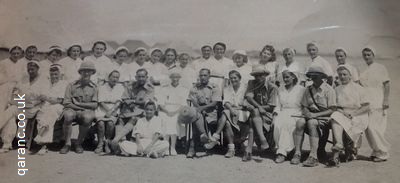
I found quite a number of well educated women amongst the campers. They also came along to help in the hospital kitchens, but before these women were able to work clothes had to be found as they had only dirty rags on. Some of these refugees were fully trained matrons and sisters from Polish hospitals who had been taken as prisoners. Their bodies were covered with weals, scars and cuts, and they had sore feet from tramping many miles. The American Embassy in Teheran gave us wonderful assistance in getting things, as also did the Indian Red Cross. As prisoners, it appeared the higher the class the worse the treatment given. These ladies had been made to clean public lavatories, sweep roads and help the men to cut down trees.
One day I approached some of their medical officers, including Colonel Anders (later General) asking them to give Red Cross lectures, and this was done. They were very keen, the classes ending with over two hundred students. I had some of my RAMC lectures with me and these were interpreted into their own language. On examination they passed out with good marks and eventually they were dressed in khaki and given the same grading and pay as the soldiers. They soon picked up in health after receiving good food and treatment. As the men got discharged from hospital they reorganised a unit and started training again. How they dreaded this time. It was pathetic to see them go because the training was for active service.
I found a matron - a very experienced woman - amongst a batch of refugees. She had been in charge of a large medical training school in Cracow and had remained behind until her hospital had been evacuated. She had also been very badly treated. I took her under my wing as an assistant matron and trained her how to organise and run a field hospital. When the patients started to get their discharges in fairly large numbers, the Polish Government began to open up hospitals of their own in the Middle East. The Polish matron was appointed their matron-in-chief, and the nurses trained at 34th CGH also went.
The removal of the dead was a problem. The Nursing Sepoys would not touch them - it was their religion, and considered unclean. The lower caste Indians called Sweepers had this duty to perform. There was hundreds of dead among the new batches arriving, and due to the climate and diseases their bodies had to be buried within a few hours. Wild animals prowling around would often carry the bodies away. A large tent was erected to receive the bodies and this was guarded day and night. In the shadow of an 18,000ft mountain the Polish refugees dug a large common grave, quite a number having to be buried as unknown. One morning several bodies had been removed from the hospital tents but had not arrived at the special tent. The fact was reported, and on investigation the Sweepers were found in a hollow dug in the sands playing a game of shove-a-penny with the dead bodies lying on the ground beside them. They said they had got tired of doing this sort of work, so, as a punishment, this fatigue soon had another job given them where they had to work very hard.
More QAs and Indian assistant nurses arrived, making the number up to thirty. The Indian Government had sent sisters and nurses over to help. I was fortunate in having the loyalty of all my staff, which included British, Indian and Polish, one hundred and seventy in all, and, through good team work, there was no illness amongst the staff. I think that working and sleeping in open tents kept everyone fit. The staff having been increased, we were able to take proper off-duty time with a clear conscience. This time was spent going into the city for shopping and sightseeing. In the early days the city was out of bounds to British sisters as we had been threatened with death, the Persians accusing us of bringing diseases to Teheran, but as nothing happened they began to realise we would do them no harm and they would benefit by our shopping. The shops were full of wonderful things, but much too expensive for us to buy though by this time our garments sadly needed replenishing. Stockings could not be bought for less than £5 a pair in Persian money, shoes being £6 to £20. After appealing to HQ in Baghdad, an officers' shop was opened in the town, to where British male and female uniforms were sent by plane. Even our shoes were past repairing.
German paratroopers had been seen coming down, some having been captured in the Caucasus, so in July 1942 British and American troops began to arrive in the north to meet what they thought was going to be a grave situation, The enemy was advancing and was expected to cross the Caspian Sea or come over the mountains. Guns and bombing could be heard in the distance. The authorities thought the work, as far as the Poles were concerned, had finished. So the 34th CG Hospital began to pack up. British and American hospital units began to come up the line. They were very lucky in taking over a half-finished modern German hospital that had every luxury. They were horrified to find that a large Indian hospital was under canvas on the plain and remaining through heavy snows and heat, but I would not change my life for the comfort of bricks. My British staff were redrafted to their own units, but the Indian nurses remained with me.
Refugees were still coming through at the rate of 5,000 a day. By April 6th, 19,000 Poles had been moved, and when the number reached 44,000 we thought the movement had finished. News came through that it was possible a second evacuation would take place later, though by now only a skeleton staff remained. One such patient was trainee nurse Danuta Maczka Gradosielska.
Lieutenant Colonel Hughes journal continues on the 18th Indian General Hospital World War Two page.
Follow us on Facebook, Instagram and Twitter.
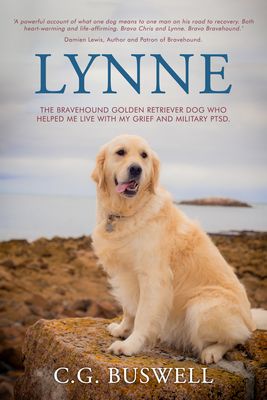
My PTSD assistance dog, Lynne, and I have written a book about how she helps me with my military Post Traumatic Stress Disorder, anxiety, and depression. I talk about my time in the QAs and the coping strategies I now use to be in my best health.
Along the way, I have had help from various military charities, such as Help for Heroes and The Not Forgotten Association and royalties from this book will go to them and other charities like Bravehound, who paired me with my four-legged best friend.
I talk openly about the death of my son by suicide and the help I got from psychotherapy and counselling and grief charities like The Compassionate Friends.
The author, Damien Lewis, said of Lynne:
"A powerful account of what one dog means to one man on his road to recovery. Both heart-warming and life-affirming. Bravo Chris and Lynne. Bravo Bravehound."
Download.
Buy the Paperback.
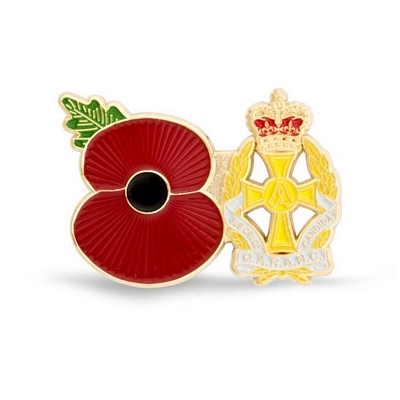
This beautiful QARANC Poppy Pin Badge is available from the Royal British Legion Poppy Shop.
For those searching military records, for information on a former nurse of the QAIMNS, QARANC, Royal Red Cross, VAD and other nursing organisations or other military Corps and Regiments, please try Genes Reunited where you can search for ancestors from military records, census, birth, marriages and death certificates as well as over 673 million family trees. At GenesReunited it is free to build your family tree online and is one of the quickest and easiest ways to discover your family history and accessing army service records.
More Information.
Another genealogy website which gives you access to military records and allows you to build a family tree is Find My Past which has a free trial.

Former Royal Air Force Regiment Gunner Jason Harper witnesses a foreign jet fly over his Aberdeenshire home. It is spilling a strange yellow smoke. Minutes later, his wife, Pippa, telephones him, shouting that she needs him. They then get cut off. He sets straight out, unprepared for the nightmare that unfolds during his journey. Everyone seems to want to kill him.
Along the way, he pairs up with fellow survivor Imogen. But she enjoys killing the living dead far too much. Will she kill Jason in her blood thirst? Or will she hinder his journey through this zombie filled dystopian landscape to find his pregnant wife?
The Fence is the first in this series of post-apocalyptic military survival thrillers from the torturous mind of former British army nurse, now horror and science fiction novel writer, C.G. Buswell.
Download Now.
Buy the Paperback.
If you would like to contribute to this page, suggest changes or inclusions to this website or would like to send me a photograph then please e-mail me.
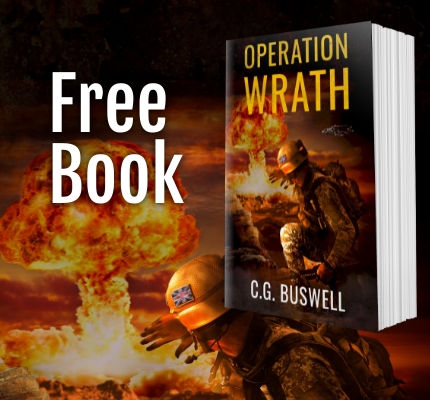
Free Book.
The death of the Brotherhood will be avenged.
RAF gunner Jason Harper and a team of Special Air Service operators are enraged after the death of their brothers by a terrorist drone strike. They fly into south-eastern Yemen on a Black-op mission to gather intelligence and avenge the death of their comrades.
Can they infiltrate the Al-Queda insurgents' camp, stay undetected, and call down their own drone missile strike and get home safely?
Will they all survive to fight another day?
Operation Wrath is a free, fast-paced adventure prequel to the non-stop action The Fence series by military veteran author C.G. Buswell.
Download for free on any device and read today.
This website is not affiliated or endorsed by The Queen Alexandra's Royal Army Nursing Corps (QARANC) or the Ministry of Defence.
» Contact
» Advertise
» QARANC Poppy Pin
» Poppy Lottery
» The Grey Lady Ghost of the Cambridge Military Hospital Novel - a Book by CG Buswell
» The Drummer Boy Novel
» Regimental Cap Badges Paintings
Read our posts on:
Offers
» Army Discounts
» Claim Uniform Washing Tax Rebate For Laundry
» Help For Heroes Discount Code
» Commemorative Cover BFPS 70th anniversary QARANC Association

Present Day
» Become An Army Nurse
» Junior Ranks
» Officer Ranks
» Abbreviations
» Nicknames
» Service Numbers
Ministry of Defence Hospital Units
» MDHU Derriford
» MDHU Frimley Park
» MDHU Northallerton
» MDHU Peterborough
» MDHU Portsmouth
» RCDM Birmingham
» Army Reserve QARANC
Photos
» Florence Nightingale Plaque
» Photographs
Uniform
» Why QA's Wear Grey
» Beret
» Army Medical Services Tartan
» First Time Nurses Wore Trousers AV Anti Vermin Battledress
» TRF Tactical Recognition Flash Badge
» Greatcoat TFNS
» Lapel Pin Badge
» Army School of Psychiatric Nursing Silver Badge
» Cap Badge
» Corps Belt
» ID Bracelet
» Silver War Badge WWI
» Officer's Cloak
» QAIMNSR Tippet
» QAIMNS and Reserve Uniform World War One
» Officer Medal
» Hospital Blues Uniform WW1
Events
» Armed Forces Day
» The Nurses General Dame Maud McCarthy Exhibition Oxford House London
» Edinburgh Fringe Stage Play I'll Tell You This for Nothing - My Mother the War Hero
» Match For Heroes
» Recreated WWI Ward
» Reunions
» Corps Day
» Freedom of Rushmoor
» Re-enactment Groups
» Military Events
» Remembrance
» AMS Carol Service
» QARANC Association Pilgrimage to Singapore and Malaysia 2009
» Doctors and Nurses at War
» War and Medicine Exhibition
» International Conference on Disaster and Military Medicine DiMiMED
» QA Uniform Exhibition Nothe Fort Weymouth
Famous QA's
» Dame Margot Turner
» Dame Maud McCarthy
» Lt Col Maureen Gara
» Military Medal Awards To QAs
» Moment of Truth TV Documentary
» Sean Beech
» Staff Nurse Ella Kate Cooke
Nursing
Nursing Jobs Vacancies UK
International Nurses Day
International Midwife Day
Info
» Search
» Site Map
» Contact
» Other Websites
» Walter Mitty Military Imposters
» The Abandoned Soldier
We are seeking help with some answers to questions sent by readers. These can be found on the Army Nursing page.
» Find QA's
» Jokes
» Merchandise
» Mugs
» Personalised Poster
» Poppy Badges
» Stamp
» Teddy Bears
» Pin Badges
» Wall Plaques
» Fridge Magnet

